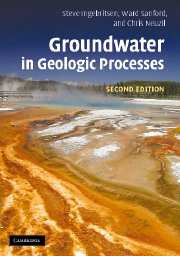Book contents
- Frontmatter
- Contents
- Preface
- Acknowledgements
- List of symbols
- 1 Groundwater flow
- 2 Hydromechanical coupling
- 3 Solute transport
- 4 Heat transport
- 5 Regional-scale flow and transport
- 6 Ore deposits
- 7 Hydrocarbons
- 8 Geothermal processes
- 9 Earthquakes
- 10 Evaporites
- 11 Compaction and diagenesis
- 12 Metamorphism
- 13 Subsea hydrogeology
- References
- Index
13 - Subsea hydrogeology
Published online by Cambridge University Press: 12 January 2023
- Frontmatter
- Contents
- Preface
- Acknowledgements
- List of symbols
- 1 Groundwater flow
- 2 Hydromechanical coupling
- 3 Solute transport
- 4 Heat transport
- 5 Regional-scale flow and transport
- 6 Ore deposits
- 7 Hydrocarbons
- 8 Geothermal processes
- 9 Earthquakes
- 10 Evaporites
- 11 Compaction and diagenesis
- 12 Metamorphism
- 13 Subsea hydrogeology
- References
- Index
Summary
In the twentieth century, perhaps only the plate tectonic revolution had a greater impact on our understanding of Earth processes than the discovery and exploration of subsea hydrothermal systems. Both focused and diffuse hydrothermal discharge are linked to tectonic spreading and shallow magmatism along the mid-ocean ridge (MOR), where new oceanic crust is continuously created. Subsea hydrothermal activity on the MOR and its flanks has been recognized as critically important to the Earth's thermal budget and to global geochemical cycles. Further, the discovery of associated ecosystems based on chemosynthetic bacteria (see, e.g., the review by Lutz and Kennish, 1993) may hold implications for the origins of life on Earth.
In this chapter we will treat subsea hydrothermal systems within the broader context of “subsea hydrogeology” – that is, the flow of aqueous fluids beneath the seafloor.We will begin by contrasting subsea and subaerial systems, and then discuss the subsea permeability structure and density-driven subsea flow. The remainder of the chapter is generally organized by tectonic setting – from MOR (creation of oceanic crust) to subduction zone (destruction of crust) – in recognition of the controlling influence that tectonic setting exerts on subsea hydrogeology (Figure 13.1).We will discuss MOR hydrothermal systems; the role of seamounts in controlling patterns of flow in intraplate settings; the distribution and significance of gas hydrates along continental margins; accretionary prisms and subduction zones; and the nearshore environment, where submarine discharge of meteoric groundwater effectively couples subaerial and subsea hydrogeology. Finally, we will discuss the possible role of subsurface flow in governing the water balance of the world ocean.
Subsea versus subaerial hydrogeology
Any distinction between subsea and subaerial hydrogeology is in some sense artificial, in that most of the same process considerations (Chapters 1–4) apply in both environments and that, for example, ore deposits (Chapter 6), hydrocarbons (Chapter 7) and earthquakes (Chapter 9) occur both onshore and under the sea. Further, submarine discharge of (meteoric) groundwater links terrestrial and submarine hydrogeology. Nevertheless, there are important practical and conceptual differences between subaerial and subsea hydrogeology.
From a practical perspective, subsea systems are obviously less accessible to drilling, sampling, and hydraulic measurement. This difficulty has been vitiated to some extent by 35-plus years of scientific ocean drilling as part of the Deep Sea Drilling Project (DSDP) and the Ocean Drilling Program (ODP).
- Type
- Chapter
- Information
- Groundwater in Geologic Processes , pp. 412 - 455Publisher: Cambridge University PressPrint publication year: 2006

